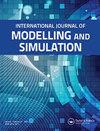Static, dynamic, and fatigue life investigation of a hip prosthesis for walking gait using finite element analysis
IF 3.1
Q1 ENGINEERING, MULTIDISCIPLINARY
INTERNATIONAL JOURNAL OF MODELLING AND SIMULATION
Pub Date : 2023-05-09
DOI:10.1080/02286203.2023.2212346
引用次数: 1
Abstract
ABSTRACT Total hip arthroplasty (THA) is a common procedure that is performed for elderly people who suffer from hip pain and other hip-related problems. THA is an operation where an artificial joint is implanted in the femur and acts as the hip joint. THA has seen advancement to a greater extent in the 20th century. In this work, a novel hip implant design is proposed based on the existing literature data. The hip implants were provided with radial clearance between the head and stem junction. This implant design is analyzed by applying a walking gait that has been clinically prerecorded. Linear and volumetric wear rates are estimated at the head-stem junction, head-liner, and liner to acetabulum using Archard’s wear law. Total deformation, von Mises stress, contact stress, linear and volumetric wear rates were reported. The volumetric wear rate was found to be less than the existing literature, achieving the goal of increasing the life expectancy of the total hip prosthesis. The maximum wear rate is found at the head-stem junction for press-fit. It is observed that when the acetabular cup and femoral head are made of CoCr (Cobalt-Chromium) alloy, the liner with Ultra high molecular weight polyethylene (UHMWPE) and the stem with titanium alloy have a lesser wear rate when compared to other material combinations. Further, it is also found that the fatigue life of Ti (Titanium) alloy is higher than that of CoCr alloy and Ti alloy material combinations have the maximum factor of safety.步态髋关节假体的静态、动态和疲劳寿命有限元分析
摘要全髋关节置换术(THA)是为患有髋关节疼痛和其他髋关节相关问题的老年人进行的一种常见手术。THA是一种将人工关节植入股骨并充当髋关节的手术。THA在20世纪取得了更大的进步。在这项工作中,基于现有的文献数据,提出了一种新颖的髋关节植入物设计。髋关节植入物在头部和脑干交界处之间具有径向间隙。这种植入物的设计是通过应用临床上预先记录的行走步态来分析的。使用Archard磨损定律估计头-杆连接处、头衬垫和衬垫至髋臼处的线性和体积磨损率。报告了总变形、von Mises应力、接触应力、线性和体积磨损率。体积磨损率低于现有文献,达到了提高全髋关节假体预期寿命的目标。最大磨损率出现在压配合的阀杆接头处。观察到,当髋臼杯和股骨头由CoCr(钴铬)合金制成时,与其他材料组合相比,具有超高分子量聚乙烯(UHMWPE)的衬垫和具有钛合金的柄具有较小的磨损率。此外,还发现Ti(钛)合金的疲劳寿命高于CoCr合金,并且Ti合金材料组合具有最大的安全系数。
本文章由计算机程序翻译,如有差异,请以英文原文为准。
求助全文
约1分钟内获得全文
求助全文
来源期刊

INTERNATIONAL JOURNAL OF MODELLING AND SIMULATION
Engineering-Industrial and Manufacturing Engineering
CiteScore
6.10
自引率
32.30%
发文量
66
期刊介绍:
This journal was first published in 1981 and covers languages, hardware, software, methodology, identification, numerical methods, graphical methods, VLSI, microcomputers in simulation, and applications in all fields. It appears quarterly.
 求助内容:
求助内容: 应助结果提醒方式:
应助结果提醒方式:


